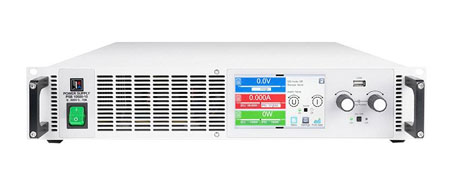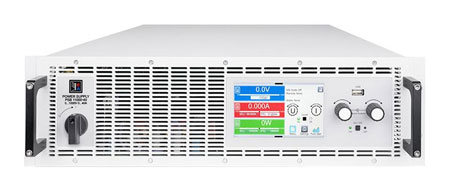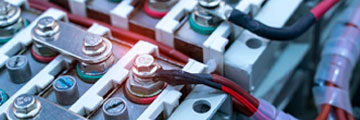
EA Elektro-Automatik bidirectional DC power supplies
Programmable power supply and regenerative load all in one
EA-PSB 10000 3U and 2U series
The EA-PSB series bidirectional DC programmable power supply with integrated, regenerative electronic load series can sink (absorb) current and recover up to 96% of current, returning it to the local power grid. Regenerative PSBs reduce heat, noise and HVAC costs, making them cost-effective and environmentally friendly.
Features
Master-Auxiliary-Bus for parallel connection
Analog / USB interface, further options retrofittable
Microprocessor (FPGA) controlled
Internal resistance control
Battery test mode
Safety compliant to IEC/EN 61010
Arbitrary generator & car startup curve
Optional: Digital, swappable interface modules
SCPI and ModBus protocol
LabView VIs and control software
High resolution of up to 16 Bit
EMI compliant to EN 55022 class B
What is a bidirectional power supply?
A bidirectional power supply is used to provide and absorb the flow of electrical energy in both directions. For example, it can supply electrical energy to a device or circuit and absorb electrical energy from it. In this case, it acts as a “sink” to absorb excess energy, convert it back to usable form, and manage power flow efficiently.
A bidirectional power supply is often used in constant voltage (CV) or constant current (CC) mode to simulate a rechargeable battery for a device under test (DUT). A bidirectional power supply then acts as a versatile tool to test and evaluate electronic devices, as it allows engineers to better understand how a device or circuit will operate through voltage fluctuations or below its nominal operating current.

True autoranging
All EA bidirectional DC power supplies offer true autoranging which means that the full source and sink power of the devices is available over a wider operating range. The lower the current required in these ranges the higher the voltage available to maintain full power output. This allows a wider range of DUTs to be tested with a single power supply. EA’s autoranging feature provides full power, output as well as input, all the way down to 33% of system voltage and current.
Regenerative
The PSB is bidirectional, meaning it can source (provide) or sink (absorb) current and regenerate that current to the local power grid with up to 96% efficiency. The PSB can do this because of the built-in regenerative electronic load. This had the advantage of significantly reducing heat and saving electrical and HVAC costs through operation. Thus the PSB is a very green solution that is good for the environment and has low impact to the working space in terms of heat while reducing overall space requirement (combining a power supply and load into one asset). The EA bidirectional solution is also friendly for your investment ROI!


Arbitrary waveform - function generator
A common requirement for programmable DC power supplies is to deliver the output voltage or current with a programmed pattern other than a straight-line DC signal. EA’s built-in function generator includes options for various typical waves such as sine, triangle, rectangle, and trapezoid waveforms, as well as custom programmed arbitrary waveforms. Additionally, provided are configuration tools for ramping, UI and IU tables, as well as simulations for fuel cells and photovoltaics with MPP tracking.
Shop products
EA-PSB 10000 2U

Power Connection : 100-240+10 % 1ph
Voltage : 0-10V to 0-1500V
Current : 0-6A to 0-120A
Power : 600-3000W
EA-PSB 10000 3U

Power Connection : 208-480+10 % 3ph
Voltage : 0-10V to 0-2000V
Current : 0-20A to 0-510A
Power : 5 kW / 10 kW / 15 kW
Videos
Resources

Application note: Make a wise choice for your next power supply
Find out more